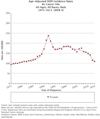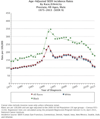The effect of the USPSTF PSA screening recommendation on prostate cancer incidence patterns in the USA
- PMID: 27995937
- PMCID: PMC5341610
- DOI: 10.1038/nrurol.2016.251
The effect of the USPSTF PSA screening recommendation on prostate cancer incidence patterns in the USA
Abstract
Guidelines regarding recommendations for PSA screening for early detection of prostate cancer are conflicting. In 2012, the United States Preventive Services Task Force (USPSTF) assigned a grade of D (recommending against screening) for men aged ≥75 years in 2008 and for men of all ages in 2012. Understanding temporal trends in rates of screening before and after the 2012 recommendation in terms of usage patterns in PSA screening, changes in prostate cancer incidence and biopsy patterns, and how the recommendation has influenced physician's and men's attitudes about PSA screening and subsequent ordering of other screening tests is essential within the scope of prostate cancer screening policy. Since the 2012 recommendation, rates of PSA screening decreased by 3-10% in all age groups and across most geographical regions of the USA. Rates of prostate biopsy and prostate cancer incidence have declined in unison, with a shift towards tumours being of higher grade and stage upon detection. Despite the recommendation, some physicians report ongoing willingness to screen appropriately selected men, and many men report intending to continue to ask for the PSA test from their physician. In the coming years, we expect to have an improved understanding of whether these decreased rates of screening will affect prostate cancer metastasis and mortality.
Conflict of interest statement
Figures



References
-
- Moyer VA. Screening for prostate cancer: U.S. Preventive Services Task Force recommendation statement. Ann Intern Med. 2012;157:120–134. - PubMed
-
- USPSTF. U.S. Preventive Services Task Force. Screening for prostate cancer: recommendation and rationale. Ann Intern Med. 2002;137:915–916. - PubMed
-
- USPSTF. Screening for prostate cancer: U.S. Preventive Services Task Force recommendation statement. Ann Intern Med. 2008;149:185–191. - PubMed
Publication types
MeSH terms
Substances
Grants and funding
LinkOut - more resources
Full Text Sources
Other Literature Sources
Medical
Research Materials
Miscellaneous

